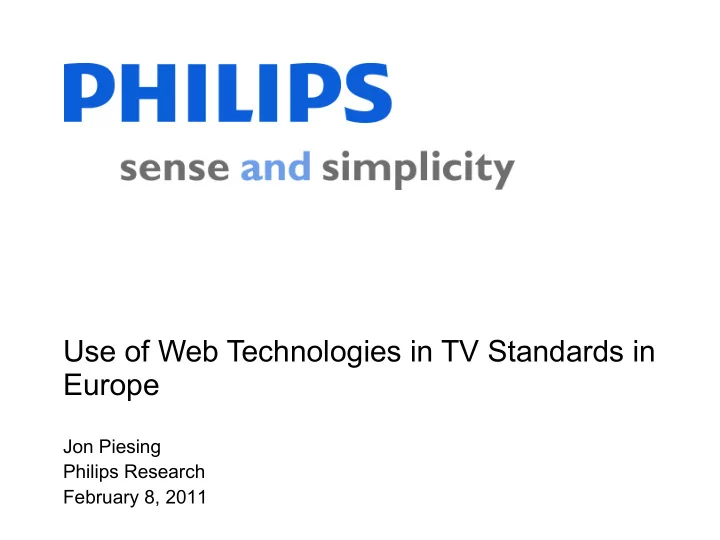

Use of Web Technologies in TV Standards in Europe Jon Piesing Philips Research February 8, 2011
Summary • TV Standards in Europe using Web Technologies – Scope – Examples • Web Technologies Used • Incremental extensions to web technologies • Other System Components • Web technologies as components of non-standard solutions Confidential 2 Philips Research, February 8, 2011, W3C Web on TV Conference
Scope • Typically these standards are a (mostly) complete system description – not just a presentation technology • They include; – Still image formats – Video and audio codecs, system layers – Broadcast and broadband transport protocols • Both for the presentation technology and for video/audio – Rules for starting and stopping applications / services / .. including signalling in the broadcast to drive these rules – Security • Trust models for applications • Content protection (incl. but not limited to DRM) • Historically big debates about the goal – Making existing web content work on TV – Use of web technologies to create TV focussed services – Or something in between Confidential Philips Research, February 8, 2011, W3C Web on TV Conference
Examples • DVB-HTML – Developed by DVB in 2000/2001 as an alternative to / alongside Java in their Multimedia Home Platform – Not widely adopted - used in some MHP deployments for basic teletext services (e.g. Telenet in Belgium, Poland, ..) • Open IPTV Forum Declarative Application Environment (DAE) – Developed in 2008/9 – Starts from CEA-2014 as used for remote UI in DLNA • Includes more W3C specifications than CEA-2014 revision A • Most of the incrememental extensions defined by CEA are omitted • Uses the CEA-2014 A/V <object> for presenting on-demand video since it pre- dates the HTML 5 Media Tags – Defines new <object> types and JavaScript APIs for many TV functions – More detailed presentation later in this workshop Confidential Philips Research, February 8, 2011, W3C Web on TV Conference
Examples • HbbTV – Developed in 2009 – Combines a selection from OIPF specifications with a selection from the broadcast transport and signalling spec used by DVB-HTML – Ruthless focus on simplicity and time to market – Being deployed in Germany, will be deployed in France in 2011 – Adopted as ETSI TS 102 796 in June 2010 • UK DTG Connected TV – Developed in 2010/11 – Very large intersection with HbbTV but includes more from OIPF – Includes advanced graphics (CSS3, HTML5 Canvas, …) – Includes more than one application running at one time & (Web) Notifications – More detailed presentation later in this workshop Confidential Philips Research, February 8, 2011, W3C Web on TV Conference
Web Technologies Used • DVB-HTML – Based on “XHTML Modularization”, ECMA-262, CSS 2 (aligned with CSS-TV), DOM- 2 (core, views,style, events) • OIPF DAE – Based on XHTML 1.0, CSS 2.1, ECMA-262 3 rd edition, pieces of DOM-0, DOM-2 (core, events, HTML, views), XMLHttpRequest – Optional SVG 1.2 – HTML 5 Media Tags, W3C widgets, others added in release 2 – More detailed presentation later in this workshop • HbbTV – Same web technologies used as mandatory ones in OIPF release 1 • UK DTG CTV – Includes all mandatory web technologies in OIPF – More detailed presentation on extensions later in this workshop Confidential Philips Research, February 8, 2011, W3C Web on TV Conference
Incremental Extensions to Web Technologies • DVB-HTML – Application lifecycle, synchronising to video, dvb-tv media type, @dvb- viewport, Key Events, custom HTML DOM, custom CSS DOM • OIPF DAE – Broadcast TV, video presentation, channel lists, favourite lists, … – Recording / download of TV content, management and playback – Parental access control & exchange of messages with DRM agent – Application lifecycle, query device capabilities, communication services • HbbTV – Selection from OIPF release 1 – Additional support for synchronising to video • UK DTG CTV – Selection from HbbTV / OIPF release 1 – UK specific extensions to OIPF Confidential Philips Research, February 8, 2011, W3C Web on TV Conference
Other System Components • Broadcast – AVC and MPEG-2 video codec – HE-AAC, MPEG-1 L2 and perhaps Dolby E-AC3 audio codecs – DVB/EBU subtitles – MPEG-2 transport stream as a container format – Carriage of files of an application through the broadcast – Linkage from a TV channel to specific applications/pages/.... • Broadband – Same video, audio, subtitle and container formats as broadcast • Perhaps minus the legacy MPEG-2 video and audio codecs • Perhaps MP1 L3 and/or WAV added as stand-alone audio formats – MP4 files as a container, both fragmented and unfragmented – Broadband video streaming protocol Confidential Philips Research, February 8, 2011, W3C Web on TV Conference
Other System Components • Security – Trust models for applications • Either fine grained (DVB-HTML, OIPF) or coarse (trusted or not – HbbTV / CTV) • How does an application become trusted? – Content protection • DRM • Device authentication • Encryption of content between the service provider and the device without the burden of DRM Confidential Philips Research, February 8, 2011, W3C Web on TV Conference
Web technologies as components of non- standard solutions • Many non-standardised solutions include web technologies as one part of a solution where other aspects are non-standard. – Details are frequently proprietary • There are several HTML 4 + JavaScript deployments – Many IPTV operators use a browser to provide either • The operator's UI and/or • 3 rd party applications – Virgin Media in the UK use the old Liberate solution based on HTML 3.2. • Their EPG is rumoured to be entirely written in JavaScript – not really HTML. – Some (not all) of the CE manufacturer “Connected TV” solutions include a browser. Some are closer to standards than others. Confidential Philips Research, February 8, 2011, W3C Web on TV Conference
Recommend
More recommend